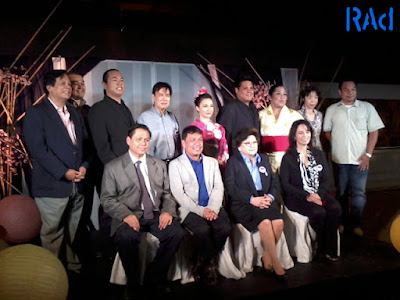 |
| Mako Nishimoto and Dante Alcalá |
Featuring:
Mako
Mishimoto, soprano
Dante
Alcalá, tenor
Camille
Lopez-Molina, soprano
Andrew
Fernando, baritone
Philippine Philharmonic Orchestra
Lim Yau, conductor
The
year 2012 is truly on its way to becoming a banner year for opera in the
Philippines as Madame Butterfly had a successful two night performance at the
Cultural Center of the Philippines. Japanese soprano Mako Nishimoto, Mexican
tenor Dante Alcalá with local prides baritone Andrew Fernando and soprano
Camille Lopez-Molina were showered with praises and an extended standing
ovation from the audience during this very limited engagement presented by
MusicArtes, Inc. and the CCP. This staging of Madame Butterfly, last seen in Manila
since 1994, was directed by Dr. Anton Juan with music direction by Maestro
Francisco Feliciano while Maestro Lim Yau conducted the Philippine Philharmonic Orchestra.
The
audience who flocked to the Tanghalang Nicanor Abelardo (CCP Main Theater) was
treated to a stylized and an unconventional version of Madame Butterfly
compared to the more traditional and straightforward staging of La Traviata
months before. Right from the start, the beating of the taiko drums instead of
the usual strings of the orchestral prelude signaled that this Madame Butterfly
would not be the typical one. This prologue also indicated that this story was
told from the perspective of a child, the one that was borne out of ill-fated
romance of the lead characters, Cio-Cio San (Mako Nishimoto) and B.F. Pinkerton
(Dante Alcalá). The images projected on stage, depicting scenes from World War
II also showed that the time was moved a few decades forward. From the start of
the 20th century, the story now took place in the 1940’s as World
War II was about to explode.
One
thing that didn’t change was Giacomo Puccini’s immortal music: sweeping and
romantic, piercing right through the soul to the point that knowledge of the Italian
libretto was no longer necessary to understand the tale. Those who didn’t know
Italian were aided by superscripts but even without them, Nishimoto and Alcalá along
with the rest of the cast were able to tell the story via their voices and body
language. And speaking of body language, Nishimoto’s Cio-Cio San embodied
through her movement the change in her character as she embraced the American
ideals and lifestyle during Act II. Her Cio-Cio San, decked in 1940’s style
American dress, moved with a sense of abandonment, confidence and with a dash
of liberation. This take on Cio-Cio San made her signature aria, Un bel di a
lot more interesting. This was a stark contrast from Act I when she moved with a
lot more restraint, refinement and symmetry as her weight was distributed equally
on both legs. She eventually returned to this manner during Act III when she
wished that Pinkerton would see her as she was during their wedding day.
But
while some of the changes worked, there were some that left me a bit perplexed.
The Coro a bocca chiusa or the Humming Chorus and the subsequent orchestral piece that connected Acts II
and III was accompanied by a dream sequence. This sequence featured a butoh dance number that had the
cast wearing costumes that glowed in the dark designed by Leeroy New. The
effect of the UV light on the strange and alien-like fluorescent additions to
the costumes was very interesting but I couldn’t unite it with the overall look
and feel of the opera. I found it jarring and not a seamless fit with the already stylized
set design. Some people might think that this sequence was a stroke of genius
while others might find it a lame attempt to be spectacular. Whether people
loved it or hated it, one thing is for sure, people talked about this sequence.
 |
| Nonon Baang, George Wildsmith and Fame Flores |
Too
bad that I was only able to see the opening night of Madame Butterfly compared
to La Traviata that I was able to see thrice. But after the final show
I was still able to rush to the CCP after covering another event and joined the
rest of the cast and production staff during the after show cocktails. I find it very
rewarding to meet and interact with the performers and the people
behind the production. I find it stimulating whenever I am given the chance to
discuss with them the production and their performances, to tell them what my
observations were and how the whole experience affected me. It was a delight
having an opportunity to practice my Italian with Dante Alcalá and basically
hang out with Nonon Baang (Yamadori), and the rest of the cast as well.
Finally after many years, I’ve had my Puccini fix via Madame Butterfly. Now it’s time to prepare for some Rossini
as the next opera will be The Barber of Seville coming very, very soon.





